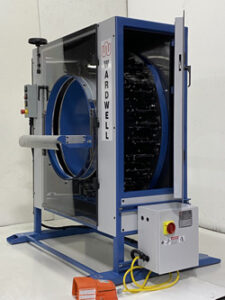Braiding: Uses and Materials
Braiding technology has been around for more than 150 years. Originally developed for textiles, it became a great way to encapsulate wire harness, especially in aerospace and other high reliability arenas. More recent developments in braiding materials have expanded its use to other industries. Some more common materials used on harnesses are copper, steel, brass, Nomex, Kevlar, polyester, nylon, fiberglass along with many others. This brief article was developed through a conversation with John Tomaz of Wardwell Braiding. We discussed the various uses of braiding and the ease of bringing this technology in-house.

There are many reasons why one may choose to braid a wire harness. First and foremost is that braiding increases the tensile strength and durability of the harness. If you are building a harness for a bus or an airplane, for example, it would likely be very long and heavy. As the harness is installed, it can be pulled against various bulkheads and cavities and the connectors and wires could become damaged. Baiding mitigates this damage by providing a tight outer barrier that resists damage to wire and connectors. The most common material in this situation would be Nomex, especially in aerospace and military applications. This will also keep the wire harness from expanding.
High vibration during the normal operation of any piece of high-reliability equipment, such as an aircraft, can cause chaffing damage to wire or connectors. Braiding greatly lessens this effect. Some common materials to reduce chafing would be steel or bronze.
Another reason you may choose to braid a harness is to protect it in a high-temperature situation, as heat can damage the various components of the harness. To reduce heat-transfer, a fiberglass braiding material is often used.
Electromagnetic interference (EMI) is a big problem in both data and signal transmission. Manufacturers are constantly seeking ways to minimize it. Braiding provides superior protection from EMI. Typically, copper or tin-plated copper braiding materials would be used in this situation. Further EMI reduction can be achieved by installing the connector over the metal braiding, thus grounding it in order to drain static electricity.
Finally, braiding can be used to create a more aesthetically pleasing final product. Common materials for this would be polyester or nylon.
Braiding can also be used as a product identifier. Many producers include a color strand or strands to identify them as the manufacturer of the cable assembly. In a 24-strand braid, for example, a manufacture could choose one or more different color spools for contact tracing.
Braiding is an easy process to learn and integrate into an existing operation. The folks at Wardwell Braiding wish to remind people that once they have acquired a machine, they can teach any mechanically inclined person how to set it up, how to operate it, and how to maintain the equipment in two days. They can do this at the customer site or at their facility. They will also provide customers with lists of braiding-specific material suppliers.
About Wardwell Braiding
Wardwell Braiding is a world leading supplier of braiding equipment. Since its founding in 1911 by Simon Wardwell, the Company’s engineers have continually introduced advances in braiding technology that have made Wardwell braiders the industry standard for overall value.






























































